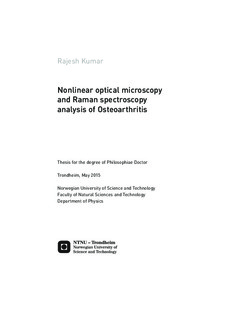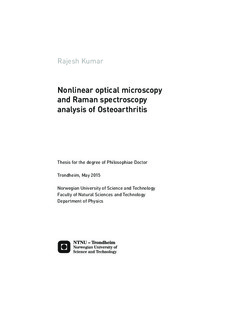| dc.contributor.author | Kumar, Rajesh | |
| dc.date.accessioned | 2015-11-16T14:52:06Z | |
| dc.date.available | 2015-11-16T14:52:06Z | |
| dc.date.issued | 2015 | |
| dc.identifier.isbn | 978-82-326-0883-6 | |
| dc.identifier.issn | 1503-8181 | |
| dc.identifier.uri | http://hdl.handle.net/11250/2360457 | |
| dc.description.abstract | Can Osteoarthritis be diagnosed at an early stage?
Osteoarthritis (OA) is a highly prevalent, disabling, complex joint disorder, and a leading cause of individual and socioeconomic burden. The tissue that contributes the most extraordinary functional capacities and forms the bearing surface of all synovial (e.g., knee) joints is the articular cartilage. Degeneration of the articular cartilage is directly associated with the progression of OA. Due to the lack of resolution and sensitivity, currently used clinical imaging modalities (e.g., X-ray, MRI, Ultrasound) are not efficient in the assessment of early cartilage disorder. Nonlinear optical imaging and Raman spectroscopy are evolving, advanced techniques that may be used for biomedical applications. By using such techniques in the analysis of different grades of osteoarthritic cartilage in humans rather than an animal model is more relevant to demomstrate clinical potential.
The goal of this thesis is to demonstrate the capability of nonlinear optical microscopy (NLOM) and Raman spectroscopy for morphological and biochemical characterization of human articular cartilage obtained from the femoral condyle of the knee. Novel morphological features (like microsplits and wrinkles) in early stage of osteoarthritic cartilage were observed by second harmonic generation (SHG) microscopy, structures that would otherwise not be visible in existing clinical imaging modalities. Within the group of ICRS Grade-I cartilage, possibly distinct phases of OA were observed. In order to perform polarization-SHG (p-SHG) microscopy, a portable polarization optical module was developed and integrated in a commercial microscope. The presence of fibrocartilage in early stage (ICRS Grade-I) of OA was observed by p-SHG microscopy. Furthermore, it was demonstrated that alteration of the collagen molecules pitch angle can be quantified by p-SHG microscopy. By using Raman spectroscopy a relative assessment of proteoglycan and amide (ordered vs. disordered protein coil) content, in different grade of osteoarthritic cartilage (ICRS Grade-I, II, III), were performed and their respective indication were discussed. Additionally, a label free investigation of single cells (chondrocytes) isolated from osteoarthritic cartilage was performed, which demonstrated that Raman micro-spectroscopy may reveal changes in biochemical compositions at the cellular level. In summary, our proof-of-principle investigation present NLOM and Raman spectroscopy as potential tools, which can assess the quality of the articular cartilage and therefore may be able to identify the stage of OA more precisely than other existing clinical modalities. An essential feature of NLOM and Raman method is that these techniques are minimally invasive and label free optical techniques. By the use of a miniaturized fiber based probe head, these techniques can be integrated with modern clinical arthroscopes and thus may potentially be used for in vivo analysis. Our proof-of-concept study encourages development of a NLOM and Raman arthroscope as a potential diagnostic tool for the use in orthopaedics. | nb_NO |
| dc.language.iso | eng | nb_NO |
| dc.publisher | NTNU | nb_NO |
| dc.relation.ispartofseries | Doctoral thesis at NTNU;2015:113 | |
| dc.relation.haspart | Paper 1:
Kumar, Rajesh; Grønhaug, Kirsten Marie; Romijn, Elisabeth Inge; Finnøy, Andreas; Davies, Catharina De Lange; Drogset, Jon Olav; Lilledahl, Magnus Borstad.
Polarization second harmonic generation microscopy provides quantitative enhanced molecular specificity for tissue diagnostics. Journal of Biophotonics 2015 ;Volum 8.(9) s. 730-739 Is not included available at http://doi.org/10.1002/jbio.201400086 | |
| dc.relation.haspart | Paper 2:
Kumar, Rajesh; Grønhaug, Kirsten Marie; Romijn, Elisabeth Inge; Drogset, Jon Olav; Lilledahl, Magnus Borstad.
Analysis of human knee osteoarthritic cartilage using polarization sensitive second harmonic generation microscopy. Proceedings of SPIE, the International Society for Optical Engineering 2014 ;Volum 9129
Is not included available at
http://doi.org/10.1117/12.2051989 | |
| dc.relation.haspart | Paper 3:
Kumar, Rajesh; Grønhaug, Kirsten Marie; Davies, Catharina De Lange; Drogset, Jon Olav; Lilledahl, Magnus Borstad.
Nonlinear optical microscopy of early stage (ICRS Grade-I) osteoarthritic human cartilage. Biomedical Optics Express 2015 ;Volum 6.(5) s. 1895-1903
Is not included available at
https://doi.org/10.1364/BOE.6.001895 | |
| dc.relation.haspart | Paper 4:
Kumar, Rajesh; Grønhaug, Kirsten Marie; Afseth, Nils Kristian; Isaksen, vidar; Davies, Catharina de Lange; Drogset, Jon Olav; Lilledahl, Magnus Borstad.
Optical investigation of osteoarthritic human cartilage (ICRS grade) by confocal Raman spectroscopy: a pilot study. Analytical and Bioanalytical Chemistry 2015 ;Volum 407.(26) s. 8067-8077
Is not included available at
https://doi.org/10.1007/s00216-015-8979-5 | |
| dc.relation.haspart | Paper 5:
Kumar, Rajesh; Singh, Gajendra Pratap; Grønhaug, Kirsten Marie; Afseth, Nils Kristian; Davies, Catharina De Lange; Drogset, Jon Olav; Lilledahl, Magnus Borstad.
Single Cell Confocal Raman Spectroscopy of Human Osteoarthritic Chondrocytes: A Preliminary Study. International Journal of Molecular Sciences 2015 ;Volum 16.(5) s. 9341-9353
Is not included available at
http:/doi.org/10.3390/ijms16059341 | |
| dc.subject | Optics and Photonics for biomedical applications, Raman spectroscopy, Nonlinear optical imaging, (Polarization-) Second Harmonic Generation Microscopy, Two- Photon Excited Fluorescence Microscopy, Articular cartilage, Collagen, Chondrocyte, Osteoarthritis | nb_NO |
| dc.title | Nonlinear optical microscopy and Raman spectroscopy analysis of Osteoarthritis | nb_NO |
| dc.type | Doctoral thesis | nb_NO |
| dc.subject.nsi | VDP::Mathematics and natural science: 400::Physics: 430 | nb_NO |

